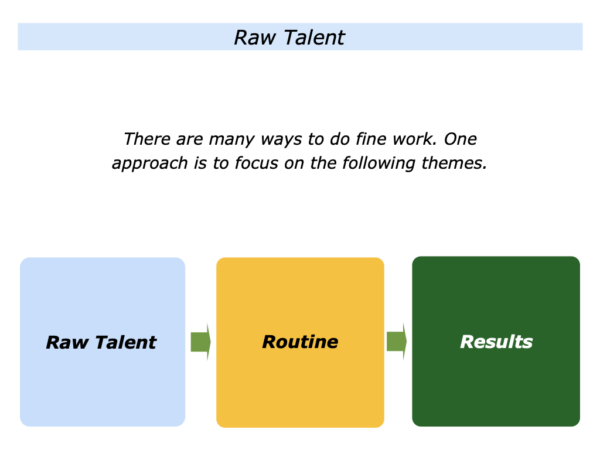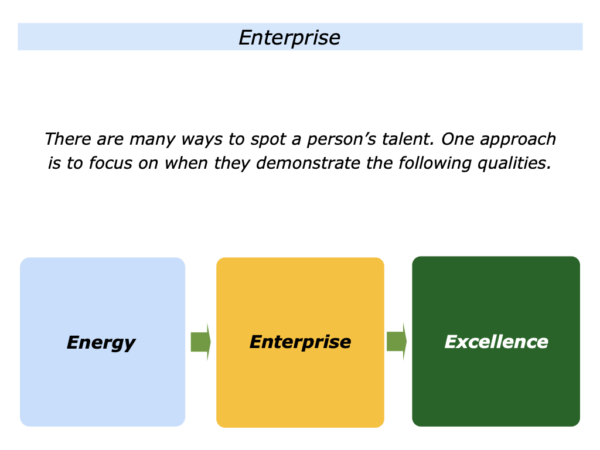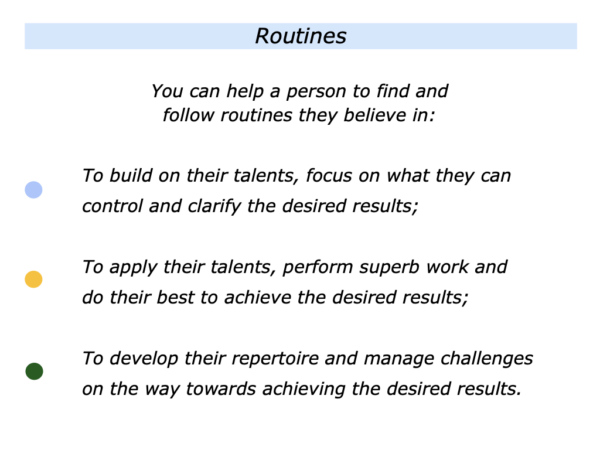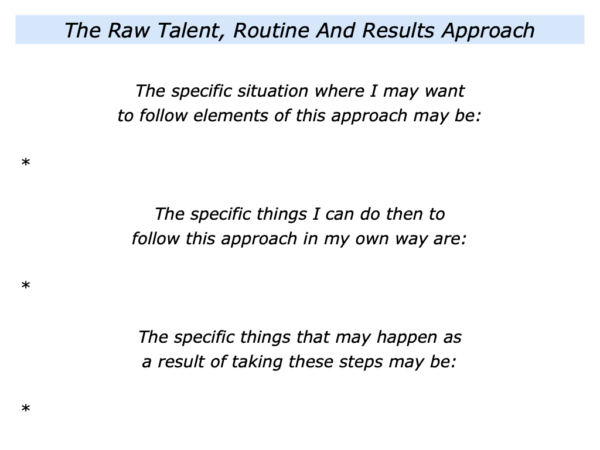
There are many ways to help a person to do superb work. One approach is to help them to build on their raw talent, follow routines they believe in and deliver the desired results.
Imagine that you are working with a person who wants to take these steps. Let’s explore how you may can help them by focusing on following themes.
Raw Talent
There are many models for spotting a person’s talents. You can look for when they are in their element – at ease and yet able to excel. There is another approach that is worth considering. This is when a person demonstrates the following qualities.

This approach involves looking for when a person comes alive. Let’s look at one example of how this can be used.
During the 1970s and 80s I ran many programmes for young people. These aimed to help them to earn a living doing satisfying work.
During the sessions I invited the young people to do many different activities. Looking at each person, the aim was spot when the individuals demonstrated the following qualities.
Energy
They were doing something they enjoyed that gave them positive energy
Enterprise
They were proactive, showed initiative and found solutions to challenges.
Excellence
They had expertise in the specific activity and the potential to deliver excellence.
Many of the individuals went on to do satisfying work. One person built and sold a company that specialised creating clothing for mountaineers, fire fighters and steeplejacks. Another built and sold companies that produced medical solutions.
The aim was to look for when a person did work they enjoyed. It was also to look for when they showed enterprise and had the expertise to maybe go on to deliver excellence.
Routine
Great workers often apply their talents by following routines they believe in. They then keep following these principles on the way towards performing superb work.
Some workers spend years before finding their successful style of working. They then keep following this framework to flow, focus and finish. Sometimes this leads to a sense of fulfilment.
Great workers often follow an organic pattern. They build on their strengths and follow their successful style of working. They do what they do best and work in the way they work best.
Some people intuitively adopt this approach early in their lives. Some people take much longer. They then keep following these principles and also add to their repertoires.
Imagine that you are helping a person to apply their talents. If appropriate, you can help them find and following routines that they believe in. This sometimes involves focusing on the following themes.

You can help the person to follow their own routine for building on their talents and setting goals. One approach is to encourage them to work through the following questions.
What are my talents? What are the specific activities where I may have the ability to deliver As rather than Bs or Cs? Which of these talents do I want to build on?
What are the things I can control when building on these talents? What are the things I can’t control? How can I build on what I can control and manage what I can’t?
Bearing in mind what I can control, how can I build on these talents? What are the goals I want to achieve? What are the desired results?
You can help the person to follow their own routine for applying their talents and doing superb work. One approach is to encourage them to work through the following questions.
How can I build on my strengths and follow my successful style of working? Looking back, what is my successful pattern for working?
When have I done successful work in the past? What did I do right then? What were the principles I followed? How can I follow those principles in the future?
What are the routines I can follow to pursue these successful patterns? What other skills can I add? How can I then perform superb work and do my best to achieve the desired results?
Imagine that you have helped a person to focus on these themes. It will then be time to move on to the next stage.
Results
Great workers often follow certain routines to keep performing superb work. They then do their best to deliver the desired results.
Such people often find and follow their successful pattern for finishing things. They may be good, for example, at managing their energy, organising their time in blocks and doing deep work.
They may be good at adding to their repertoire of skills. They may also develop their ability to anticipate challenges and manage difficult challenges.
You can help the person to follow their own routine for doing their best to achieve success. One approach is to encourage them to work through the following questions.
How can I keep performing superb work? What can I do to keep following good habits? What can I do to keep focusing on what is working and what can be improved?
What can I do to keep adding to my repertoire? How can I keep developing my strategic thinking and practical skills? How can I anticipate any manage any potential challenges?
How can I follow my successful pattern for finishing? How can I do my best to deliver the desired results? How can I deliver ongoing success?
There are many ways to help a person to develop. One approach is help them to build on their talent, follow their chosen routine and do their best to deliver the desired results.
Let’s return to your own life and work. Looking ahead, can you think of a situation where you may want to follow elements of this approach? This could be in your own life or when helping another person.
If you wish, try tackling the exercise on this theme. This invites you to complete the following sentences.







Leave a Reply